
by Karen Skidmore | 03,20 | Marketing Articles
Why is it that some people seem to just love picking up the phone. They relish the thought of speaking to people. They get excited by the prospect of prospecting. But, if you like most people who run their own business, making sales calls, reaching out to potential clients and following up on your proposals is usually NOT something you like to do. Yes, you know on a logical level that this is important, but you’ll do anything to avoid the action of doing it.
And it doesn’t matter how many templates, scripts or systems you download or try out, even with the seemingly right tools to get on with prospecting, why do you avoid doing the work?
Empty the dishwasher. Iron your socks. There are so many other important jobs that conveniently get added to your to-do list so you find yourself distracted enough to not have the time to prospect. Not enough time. Such a convenient excuse … but how is it harming your business?
What if it wasn’t the practical doing bit of prospecting that you’re struggling with? What if was the way you feeling into prospecting that was holding you back? If you were able to design and create your own rituals that allowed you to feel energetically ready for prospecting, would this make a difference? First, let’s clear on what I mean by prospecting.
What is prospecting?
Prospecting isn’t cold calling. It isn’t buying a database or sending blanket emails to any email address you can get your hands on. It isn’t buying space at an exhibition and handing out leaflets to everyone who walks past your stand.
Prospecting is the simple act of initiating or following up on a conversation with someone who you think maybe an ideal client. You may have met them before at an event. You may have even had a conversation with them in the past. They may also be someone you’ve never conversed with but you’re connected to on LinkedIn or Facebook. And they can definitely be someone you worked with before in the past or a friend or even your next-door neighbour.
My point is that anyone you feel may fit your ideal client avatar is someone you can potentially initiate a conversation about the work that you do and the services that you offer. And in this world of social media noise and trying to be visible, us small business owners and entrepreneurs have the potential of cutting through that with the simple process of reaching out to one person at a time.
You can not kid yourself that working on your marketing funnels or content or brand is enough to attract enough clients. If you are still waiting to be discovered or hoping to get to the stage of having a waiting list for your services and programmes, you simply can’t afford to wait for people to approach you. You have to spend some of your time – even if it’s just an hour a week! – to reach out to and follow up and start conversations with potential clients.
As a British person, I know how up-tight our Britishness can get us. We are historically a very polite nation who would apologise for having our foot stepped on and wait patiently in queues, with only the occasional silent tut. This Britishness can really pull a lot of people back from the idea of prospecting. Just think of the reaction you may have had when you read that a friend or a next-door neighbour could be a prospect 😉
There’s a lot of fear that comes up with prospecting, too. I get that. Your mind monkeys can get really noisy every time you even think about the idea of initiating a conversation with someone you may want to sell to.
Combine this fear with British politeness and you can find all sorts of things flying through your head …
‘I would hate to be a bother. What if I interrupt a meeting or they are in the middle of something when I called them?’
Would they really pick up the phone if they were in the middle of something important? And what if they were delighted to hear from you?
‘I hate getting emails that are trying to sell me something. I’m sure my potential clients would feel the same if I sent them all these emails that I’ve been told I have to send out.’
If you hate the emails you get that are trying to sell you something, it’s usually because you are NOT interested in what they are selling. How many times have you had an email that you’ve been really pleased to get out of the blue that’s saved you money, time or told you about something that has changed your world?
‘Those messages I get on LinkedIn, trying to get me to book a call with them, are really icky.’
Ditto as above. When you get the right message from the right person at the right time, that opportunity to speak with them directly is an amazing opportunity to get your questions answered quickly.
For every mind monkey thought, I will be able to re-frame it for you. But I don’t have the time – nor the inclination TBH! – to be doing that ALL day for you 😉
What I want to share with you today is something far more useful; a list of rituals that you could adopt to help create the right space, energy and environment to ignore the mind monkeys for a short while and make prospecting far more do-able and approachable. And, just to be clear, I’m not a natural prospector either, which is why I know how important creating rituals are in making sure it happens in my business!
What do I mean by rituals?
Most human beings are creatures of habits. Habits such as brushing your teeth in the morning or taking your supplements with your breakfast are often so ingrained that you don’t even have to think consciously about doing them. Other habits such as biting your nails or chewing on a pen can be triggered by nerves or your mind’s way of wanting you to concentrate. Some people want things in a certain way to feel comfortable and relaxed, so will have certain bedtime rituals. And others will be religious in their evening face cleansing rituals.
Rituals have a wonderful power in that they can help prepare you mentally for the task ahead and create an environment and the energy conducive for the activity you need to do.
Think back to how I joked about the dishwasher and ironing of socks being more important than prospecting. If you’re using these tactics, then this is your own way of using a ritual to avoid the task. So what if you used certain rituals to help you transition into the right state and environment for prospecting? What if you create your own habits to raise your energy, which in turn helps increase your confidence?
Here are some ideas for you.
This is by no means an exhaustive list so please write down your own ideas as they come to you. Or even share them in the comments below. I’d love to know what you try.
- Make your own Success Scrapbook and read it through before you start your prospecting. Print out, write out and stick your favourite testimonials, thank you notes and positive comments into a scrapbook so you have them all in one place. It’s really easy to forget about the nice things that are said to you throughout your working week, so keep them all together in one place and use them to remind how bloody brilliant you are before you start reaching out to people.
- Dance wildly in the kitchen. OK, so this may not be your thing but dancing whilst no one watches is a great way of getting any repressed negativity out of your system, as well as making your laugh at yourself. This is one of my favourite ways of rising my own energy.
- Clear your desk. A cluttered desk not only distracts you but can also have a detrimental effect on your clarity of thinking. If you say you like working in chaos and enjoy the creativity of having books and papers everywhere, but you still can’t ‘find the time’ to prospect (or other excuses to this effect), then I challenge you to clear some space and see what difference it makes.
- Make a cup of your favourite brew. Not only do you need to be hydrated to do your best work, the simple act of brewing your favourite tea or coffee also helps create the short time to mentally transition from your previous task to prospecting. The time it takes to boil a kettle, and stay there to watch it boil (that’s important – this ain’t a multi-task moment!), can slow down your breathing, centre your thinking on the task ahead and helps grounds you.
- Mediate. Yup, even just 5 minutes of mediation can slow you down sufficiently to feel more into your power. Laura Coleman of Be Mediation calls mediation your pause button. And this is a great practice and ritual to help calm your Mind Monkeys.
- Decide how you want to show up. I asked this to one my Momentum Pod groups the other week because we were discussing prospecting rituals. Curious, being of service and interested were some of the ideas shared. Imagine if you stepped out of those feelings of doubt and fear (don’t want to interrupt or be a nuisance) and into feelings of opportunity (I wonder who I get to speak to today?). Being conscious about this decision on how to show will have a dramatic effort on the results you get.
- Smug, burn or incense. Many of the clients I work with are what we may call spiritual. They have a strong connection with their intuition, may call themselves empaths and are more often than not introverts. They are often already using rituals such a sage smudging, lighting candles and crystals in their every-day but don’t think to use these rituals to help frame and prepare for their prospecting time. I find the simple act of lighting a candle and striking my singing bowl a really great of bridging myself into prospecting time. It connects me to who I am focusing on and helps me turn down my mind monkeys for that hour. So if this your thing, try it.
What else can you think of that you know could work for you? Music, your working environment, time of day and so many other things will affect your energy and desire to prospect. Using simple rituals like these can have a quick and immediate impact not just on the way you experience prospecting, but on your results too.
It’s all very well having the latest, sure-fire way of getting leads from LinkedIn or the best script or email templates, but if you don’t feel energetically connected with the process, you are going to do anything and everything to avoid the work. Try one or two of these rituals out and let me know how they make a difference to how you embrace your prospecting and what impact you make.
Until next time, do less, be more, play bigger.

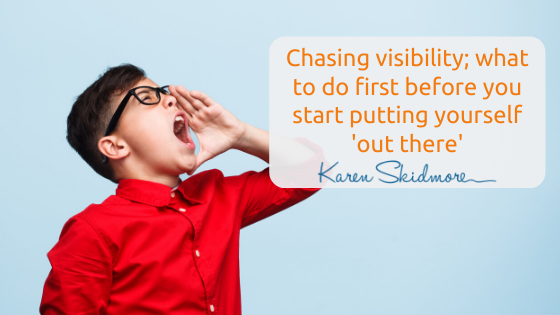
by Karen Skidmore | 03,20 | Marketing Articles
With the set up of each new social media profile, there comes the drive to get noticed. From the elders of Facebook and Twitter through to the new kids on the block of TikTok, you are taught that for them to ‘work’, your content has to be seen. But not all of us are born to be visibility extrovert. Myself included!
Some of you may start your journey into social media by lurking; silently watching, clicking and reading everyone else’s content as you scroll through your news feeds. At some point, you may feel ready to participate so you start to comment and share interesting stuff that you find useful. But you quickly realise that spending all your time reacting to what you scroll through, just becomes a huge time suck. The hours that you spend scrolling, clicking and scrolling some more, doesn’t land you any clients. Quite rightly, you begin to question what you’re doing.
But then, at some point, you find yourself falling down Alice’s rabbit hole of visibility.
Social media experts will often talk about the importance of visibility because if you aren’t seen, your potential clients are not going to find you. I am sure you already know that your clients aren’t sitting around, waiting to discover you. In fact, if you’ve been in the business game for long enough you will already know that most of your clients don’t even know they want you until you start conversing with them and exploring opportunities together. Thus starts the chase to find out how you can become visible, following the theory that if you appear more often to more people in the social news feeds, you are more likely to be found.
There are 3 big problems with this theory.
- Visibility can kick up a big shit storm for a lot of people. ‘Who am I to be sharing this?’ ‘I’m not an expert.’ ‘What if people find out I’m really a fraud?’ Even before you’ve started dealing with your content plan and what kind of posts you are going to create, the fierce winds of doubt come racing through to put a stop to any kind of activity.
- Introverts can have a huge problem with the thought of being visible. A lot of social media content and visibility strategies taught today are taught by extroverts; those people who love to be in the spotlight. It doesn’t mean introverts can’t be visible, but the way that extroverts teach visibility can frustrate a lot of people, particularly if you know you are Highly Sensitive Person (HSP).
- Some high visibility strategies can have you busy, rather than productive. Social media is NOT your only marketing tool and yet many social media marketing experts will have you believe that Facebook or LinkedIn are the only places where to find your clients. Plus it’s very easy to overcomplicate your marketing and be spending too much of your time creating multi-level funnels because that’s what you’ve been told will ‘work’ for you.
Visibility is important, and yes social media gives you the opportunity to ‘get yourself out there’. But let’s get real about what visibility really is and how it applies to you and your business. Before you start creating your content plan and psyching yourself up for your daily Facebook Lives, here are seven things to work through.
Define what visibility means to you
Before you decide to throw yourself into any visibility marketing challenge, take a moment to ask yourself what visibility means to you. With many of the clients I work with, visibility isn’t about being seen by everyone, all of the time.
Visibility is about being seen by the RIGHT people.
Before you do any work on developing a content plan or deciding to begin a daily Facebook Live practice, you have to get really clear on exactly who you want to engage with. You may call them client avatars or ideal clients, but in my experience, too many people bypass this important step of any marketing strategy.
Define how many people you really need to engage with
Another important step I help my clients work out is their Business Heartbeat. This is the number of leads, prospects and sales you need each month in order for you to make the revenue you need. When you do this work, you often find you need to be visible to far fewer people. For example, if you are selling a £2,500 product or programme, your capacity for taking on new clients maybe just four new clients a month. So if it’s just four people you need to sell to, then how many people do you really need to be visible to? This can massively help those of you who get, quite rightly, overwhelmed by feeling they have to be chasing visibility statistics such as post views, number of likes and shares.
Unfollow and declutter your own newsfeed
It’s really easy to let other people’s visibility kick up your shit storms of fears and doubts. If you struggle with comparisonitis (And who doesn’t?? It’s only human and I challenge anyone who says they never get affected by this!), then control the machine that feeds it. You have total control over what appears in your news feed.
Unfollow people who don’t inspire you or even trigger you. Don’t kid yourself that you need to know what your competitors are doing. Other people’s stuff just distracts you and you need to focus on your own game.
Unlock your limiting beliefs
Don’t just push down your fears; bring them out in the open and deal with them. Some people are able to read an inspirational quote and feel fired up enough to charge forward with a new content plan. But for most of us mere mortals, there are often some deep-rooted limiting beliefs that need unpicking.
At a recent Mastermind Day that I run for my Impact Momentum members, one of my clients opened up to some real fears about her visibility. Because of the work that she did before she started her business, she had to be very careful of how she appeared online so that patients couldn’t find and connect with her whilst she was working professionally with them. There was a genuine reason why she was finding it difficult to shift herself now into visibility mode. A daily motivational quote wasn’t going to cut it here; she had to do some work on rewiring her thinking and making sense of her new journey.
Introvert versus extrovert
The more you know yourself, the easier you will find marketing. Every one of us is unique and you will have your own set of personality traits that you can decide whether you were born with or you adopted based on life experiences. There will be some parts of your personality that you know are strengths, and there will be other parts of you that you may not like, or feel are weaknesses.
I believe that you don’t need to overcome these perceived weaknesses or that you need to have a specific entrepreneurial profile to make your marketing successful. When you accept who you are, right here and now, and know that whoever you are, you can design a business that showcases the best darn version of you. So rather than change who you are, change the way you market yourself and show up. It’s far easier. What this means is that it is OK for introverts to hate Facebook Lives. And it’s OK for extroverts to love them. You can be visible to the right people without having to do Facebook Lives; find your way of creating content, engaging and getting visible with the people who matter to you.
Know your metrics … but know that they aren’t everything
On a final note, I wanted to remind you that visibility for the sake of visibility is waste of your time and resources. The social media platforms are designed to keep you hooked. The number of likes and comments are there to draw you back in. Those three little dots that go up and down to signify that someone is commenting or responding to a message – yes, they are designed to keep you staring at the screen to wait. They have you hooked to be ready and waiting and staying online.
The algorithms share what is ‘popular’ but does that mean you only rely on their calculations to have your posts seen? No. Because you can reach out to individuals. You can engage with people. You can have conversations by picking up the phone, arrange to meet people for coffee or set up a meeting at the next conference or event you’re attending (or even speaking at). The clients I work with are never going to be social media influencers; that’s not their strategy. So be careful of being sucked into similar high visibility strategies that focus on the numbers game, rather than the impact you make with the people you want to engage with.
Visibility is important but what I hope I’ve been able to give you here today is a fresh perspective on how you approach this topic. Visibility is not just about creating content (noise?!) and sharing it on social media. Visibility could mean local networking. It could mean keynote speaking or it could be as simple as making sure you attend the top three industry conferences and events. It’s very easy to end up with over-complicated, digital marketing that ends up burning you out because you don’t enjoy the endless pressure to have to ‘show up’.
Take this time to step back and decide on how visibility can work for you and your business before you dive into creating a content plan. Visibility can be far simpler than you may think right now.
Until next time, do less, be more, play bigger.

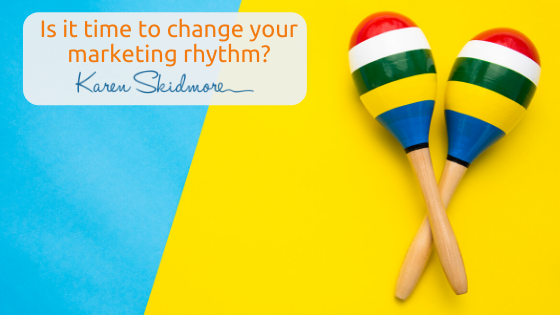
by Karen Skidmore | 02,20 | Email Marketing, Marketing Articles
Constant and consistent. It’s good advice, isn’t it? Good marketing will (almost!) always fail if you aren’t consistent with it.
I know many of you are ‘creatives’; it’s a common entrepreneurial trait. But being creative also has its challenges. You get bored easily. You enjoy starting stuff, but completing it … well, that’s an entirely different matter! So ensuring you are being consistent with your marketing is important because we all know how long it can take for many of our prospective clients to come forward and say yes to us. Yes?
If you keep chasing new ideas, you don’t follow up on leads and potential business and you miss out on sales. However, there comes a time that you may need to change the rhythm. And that’s exactly what I have decided to do with my weekly Skidmore Spark.
For the past 15 years of writing and sending out my weekly email, I have stuck to sending it out on a Thursday. There was some science behind that decision – my email statistics told me that my open rates were at their highest on a Thursday – as well as some feeling behind the decision – deciding that Wednesday was a good day to be writing my content. But, as you may be experiencing yourself, email open rates and click-throughs have been erratic, to say the least over the past year or so. Plus I was finding that I was skipping some weeks because I got too busy to write.
Too busy to write??
No, that’s no good!
That’s when I knew that my consistent Thursday rule was not getting the best from me. So I am changing my rhythm; writing the week before and scheduling this email to arrive in your inbox for Monday morning. Will it work better for me? Who knows … but I am willing to give it a try.
And this is why I wanted to share this with you today. Because I don’t think we do enough change. I’m not talking about jumping from one thing to the next. That’s not change; that’s just shiny shiny mentality, trying to find the one tactic that’s going to work because you haven’t got a strategy. The change I’m talking about here is the change to our consistency; a change brought on by the consistent thinking of what’s working, what’s not and how do we adapt to our fast-paced society and economy.
It’s easy to be always looking outside our business for answers. To be asking Google or your Facebook hive mind. But how often do you look within? How often do you review, reflect and adjust your rhythm based on what’s going on inside your business? Last week in our Momentum group we had our regular 4 Week Review & Redo. It’s everyone’s opportunity to assess their progress in their 90 Day Plan and have the opportunity to re-set their compass and change their sails, if need be.
There’s a simple three-part process:
- What do I need to stop doing?
- What do I need to start doing?
- What do I need to keep doing?
It’s a great little exercise to help you feel grounded and make sure you aren’t staying busy, running the hamster wheel. And it was from doing that exercise that I decided it was time to change the rhythm of my weekly newsletter. I realised I needed to break my Thursday send out rule because it didn’t seem to be working for me any more.
Try it out yourself. What are you consistently doing in your business? And is time for a change? I’d love to know what shows up for you.
Until next time, do less, be more, play bigger.

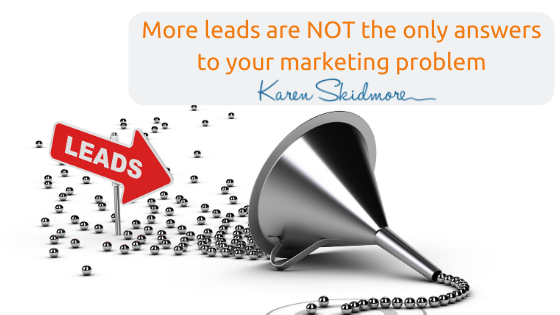
by Karen Skidmore | 11,19 | Marketing Articles, Pillar Articles
To get the leads you feel you need can be exhausting at the best of times; growing and managing free Facebook Groups, posting endless social content and running Facebook ad campaigns (that have the habit of eating up your cash flow!) are all popular ways of generating leads today. Focusing your attention on getting sign-ups to your email list or to get to people into your marketing funnel by offering low-cost digital products can be an important part of your marketing plan.
But did you know there are hidden gems and opportunities in your sales and marketing process that you may simply not be aware of?
What I want to shine the light on here today is you make you consciously aware of the exact steps your clients take with you. Because if you do, it will be far easier for you to spot where the potential opportunities are and do something about them.
And, in the process, you may actually discover that getting more leads, which can be one of the toughest and most expensive problems to solve, may not be the right thing to focus your time and energy on right now.
Let me give you a couple of examples first.
A client I worked with recently was growing her fitness business. She had been teaching Pilates for many years and as her children were growing older, she had the energy and time to step up her business. She had decided she was wanted to create some digital offerings and develop herself as a health coach, which would enable her to move away from having to teach four days a week.
She did exceptionally well in the first six months of her new business, as I helped her create huge numbers of leads through various Facebook challenges and webinars. Once she then decided she was in a position to outsource Facebook ads and hire someone else to run her campaigns, she really flew and was able to take her list from 500 to 4,000 in just three months.
But here was the problem; her sales figures were yet to go much above a few hundred pounds each month and she was struggling to sell enough of her courses to make the shift from teaching classes to online business. Her natural instinct was to go get more leads. But once I helped her shift her attention from lead generation to stages further down her sales and marketing process and work out why people weren’t buying, her business changed for the better.
She adjusted her offers, increased her prices and opened up her diary to allow her to speak to more people, rather than rely on them clicking on a sales page. The shift from only teaching in-person group classes to the online business she desired finally became a reality.
Another client I worked with earlier this year had an amazing Facebook Group, with more than 3,000 members active in it. Running free Facebook Groups is a popular marketing strategy today and, from the outside looking in, it can look like you have a thriving business. But the reality was, for this particular client, that her free Facebook members were sucking her dry of energy and enthusiasm for her business.
She was falling out of love with what she was doing and had essentially trapped herself in the lead generation stage of her marketing, drowning under all the messages, posts and day to day management of the group.
To get back on track with growing her business, I showed how to declutter her offers, streamline her prices and developed a marketing strategy that would essentially take her off Facebook so that she didn’t feel trapped, serving her free audience every day in order to grow her business.
And this is what I want to help you with today. Instead of only thinking that it’s more leads or better quality leads that you need and keep your focus on the lead generation stage, there may actually be easier and simpler solutions further down the line.
Let’s break down the stages and you’ll be able to see where you may need to shift your attention if your lead generation focus is getting you nowhere fast.
The sales and marketing process for businesses like yours can be broken down into five stages.
- Leads
- Prospects
- Conversion
- Value
- Frequency
1) Leads – these are the initial shows of interest.
Leads are not Likes on your Facebook page nor are they retweets of your blog articles (although both can give a good indication on whether you have a potential audience out there).
Leads are people who make them known to you and you have basic information about them. For example, emails subscribed to your list, registrants for your webinar or people in your free online groups. Leads are people who have shown themselves to you as being genuinely interested in what you share but all you know about them at this stage is perhaps their name or simple contact details.
Just think of leads as the initial handshake when you meet someone for the first time.
2) Prospects – these are people who have taken a step further into the enquiry process with you.
Prospects have either requested a call with you, clicked several links in your emails to your various offers, filled in an enquiry form, requested a brochure from your website or even spent money with you, but at a low price point. It’s really important that you decide on your own definition of who a prospect is for your business because every business will be slightly different here, but it doesn’t need to be complicated.
Just imagine yourself with a room full of people, who maybe have heard you speak or explain your business and they’ve put their hands (maybe only tentatively to start with), wanting to know more about what it is to you. From their actions, they are showing you that they are interested in engaging with you about what it is that you can offer them.
3) Conversion – simple really; people get to this stage when they’ve spent money with you.
If you only have a handful of leads and maybe only speaking to one prospect every few weeks, then it is unlikely that many people are going to get this stage as you’re simply not going to be able to convert everyone. So your marketing problem may still in stage one or two. Go back to getting clarity on who you are marketing to and what problems you can solve for them because if you aren’t getting that initial interest, you probably haven’t got your audience or message clear enough.
But if you have leads coming in and you are building up an email list, but not making the sales, then you actually have a different opportunity. There’s every chance you need to review your offers, your sales copy, your positioning and how easy it is for people to actually buy from you.
With many clients I’ve worked with, low pricing and poor positioning is often the marketing problem that needs solving. Perhaps you don’t enough social proof; case studies, testimonials or client stories. Maybe it’s your bootstrapping approach isn’t giving the necessary trust factor or credibility needed to win your prospects over.
In many cases, it’s the fear of picking up the phone and having a conversation that stops many people from making the right sales; if you are relying on your website and social media presence to do the work but, in reality, your prospect needs to speak with you before they are willing to invest their time and money in what you offer, then you need to step up and bring conversation selling into your marketing.
Putting in the systems to make it easy for you to arrange phone calls or meetings with your prospects can be one of the quickest ways to increase your sales next month.
4) Value – this is the total amount of money each client can spend with you.
As a rule of thumb, the lower the price you sell at, the bigger list you need. If your average client spend is under £50, your marketing strategy has to focus on volume. You need to spread yourself wide and far and your list building activities have to attract hundreds, if not thousands of new subscribers each month. If your average spend is upwards of £2,000, your focus will want to shift to qualifying your leads and prospects; it’s not just anyone who will buy what you offer so you can get laser-focused on a smaller marketplace.
What this means is that if you’re focused on the lower end of the price band and struggling to generate enough sales from your Facebook groups, social content posting or ad campaigns, perhaps your problem is your offer. As with the conversion stage, low pricing is often the problem so never assume lowering your price or offering discounts is the answer to making more sales. This tactic often does the complete opposite and lowers your total sales; you end up competing in an Amazon marketplace where your customers’ decisions are based only on price. Not a fun place for your business to be.
5) Frequency – how often your clients spends with you.
Again, if your marketing strategy is low price, high volume but if there are only one or two things to sell to them, you have some hidden gems and opportunities. A lot of people would stay in stage one and simply exhaust themselves on the treadmill of getting new leads so that more people can buy their one or two products or courses.
But what if you created a higher-priced programme or a continuity/membership offer? Developing a full product suite can take time, often a few years to get right for your audience and market place. So you need to question yourself whether you are creating the space in your day-to-day running of your business to research and develop new product offerings, ongoing servicing packages or even affiliate offers.
OK. Where do you go from here?
What I recommend you do now is to take these five stages and spend 30 minutes thinking them through in your business. Don’t go into what I call “How Do I?” mode which means you head off to google and start searching for answers to questions you don’t need to answer right now. This will only knee-jerk you into more tactics, rather than thinking strategically about the shifts you may need to take.
Take yourself away from your desk and your screens and spend half an hour or so doodling out or mind-mapping some ideas. Step away from the need from finding a quick solution right now and look at your marketing with a fresh perspective. Perhaps you need to speak some of your current clients and customers; ask them about how they are solving their problems right now. Maybe you already know, in your gut, that what you are doing just doesn’t feel right. So ask yourself what would feel right?
It’s important to give yourself this space to re-look at your current marketing plan and spot the opportunities you may be missing.
Thank you for reading. Until next time, do less, be more, play bigger.


by Karen Skidmore | 06,19 | Marketing Articles, Stories, inspirations & thoughts for the day
Do you ever wonder if anyone is actually really and truly reading, listening or watching your content?
Today, all our content can be tracked by metrics; number of likes, comments, click-throughs and shares.
But do they tell the whole story?
I was out last night with a group of wonderful women who I’ve got to know quite deeply over the last couple of years. I’ve shared wine with them, lots of laughter and, at times, tears.
We got talking about my new book due out this September and I realised how many of them not only subscribed to my email updates but also read every email.
Now I do look at my email marketing metrics.
I can see that my average open rate right now is at 38.5%, which I know is high for my industry.
But I also know that open rates don’t tell me who actually reads my emails.
It’s one thing having a cookie sent back from their email server to mine that the email has been opened, but it’s another to know that the human being who signed up for my emails has actually read it. That would be a little bit creepy, yes? Having access to your camera on your phone to see if your eyes scan through the copy … too much ‘big brother’, thank you very much.
So to hear from several of the ladies last night that they read EVERY SINGLE email from me woke me up.
It gave me a much-needed reboot and reminder that the impact that we can make from the content we create cannot be measured by metrics alone.
It’s the same with our like counts on our social media accounts.
It’s easy to believe that a post with just one or two likes hasn’t done anything; it’s just slipped through the newsfeed and allowed the algorithm to swallow it up.
But this is simply not the case.
There are dozens, if not hundreds, of the ‘right’ people who will feel inspired by your content without reacting to it. They watch, listen and read without leaving any trace, such as a click or a tracking cookie (because more people are switching these off than ever before).
What does this mean to you and me?
Firstly, it is important to recognise that you are here to run a commercial business. If you produce content for entertainment value only or just create content for the sake of creating content (think robotic, automated sharing systems that do nothing but create white noise), you end up with an expensive hobby, rather than a purposeful, profitable business.
But the feedback that I had last night from my buddies, inspired me to see that the content we create can have a greater impact than our metrics tell us.
Whether I get an email from you or not (although a reply to one of my emails boosts me no end – seriously – that quick moment of recognition makes a real difference to me), I am reminded that not everyone has time nor knows what to say to show me that they’ve read, watched or heard my content.
It’s the same for you, too.
If you ever find yourself wondering if anyone is actually really and truly listening to you, take a moment. Have the faith to stick to your plan and the impact that you are here to make. You don’t need hundreds of likes and click-throughs to tell you whether you are a success or not.
And it’s a reminder me, too, to take the time to comment or reply to the content that inspires me. A simple ‘thank you’ may be all that it takes – it doesn’t need an ‘intelligent’ or a mini-blog response that may take a half hour out of my day – but that response is my payment in kind for the content that inspires me and helps me reflect, grow or take action.
Thank you for reading. Until next time, do less, be more, play bigger.


by Karen Skidmore | 06,19 | Marketing Articles, True Profit
I see many business coaches and mentors drive their clients hard; fuelled by the likes of Gary Vaynerchuk and other high adrenaline entrepreneur gurus, many people believe that hustle and grind are proof of success. Heck, I used to do it myself back in the early days of my coaching business. ‘Work harder’, ‘do more’ and ‘push yourself out there’.
Yes, there’s no doubt that there are times you need to step up, push your shoulders back and do whatever is needed to see a project completed, or to challenge or perhaps stretch yourself when you feel uncomfortable or nervous of taking action. But taking this energy with you all day, every day is not healthy. I only have to watch three seconds of a Gary Vaynerchuck video to feel my cortisol levels rise dangerously high. If you feel the same, I want to give you permission to stop feeling that these gurus represent success; they are simply one version of success and it doesn’t have to be yours.
Success is often thought of in terms of money, and the economy and business growth can look like this line on this chart below; the more effort you put in, the bigger the results.
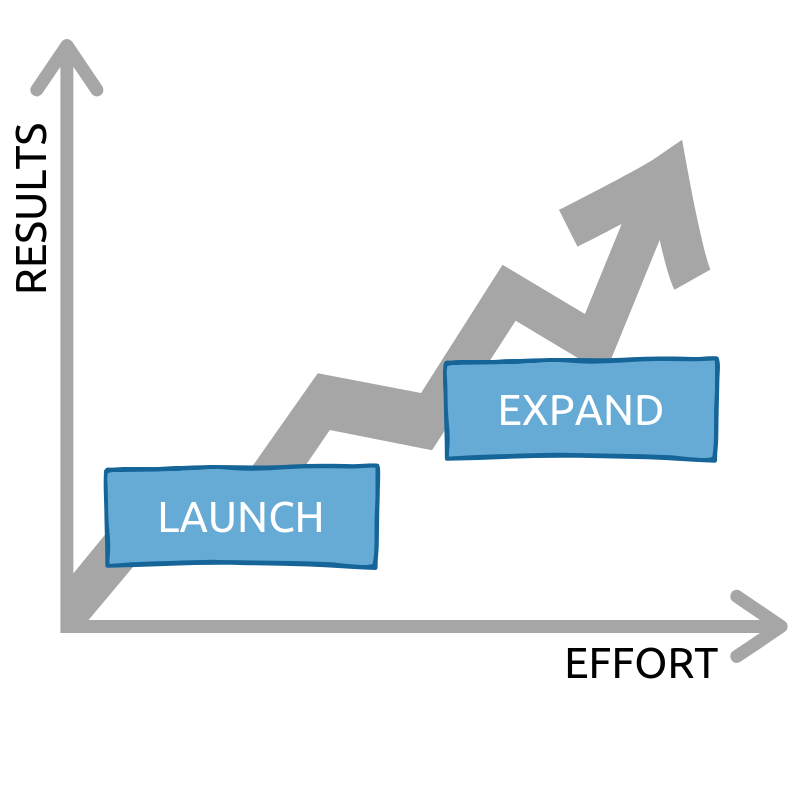
If you were to relate this to your small business, it could be simplified as two stages of growth: Launch and Expand.
Launch: get a business idea and launch it.
Expand: do more and grow.
Simple enough but this version of success rarely happens.
A more likely growth chart is that your results go up as well as down over the course of the year, as seen in the figure above. This is often called the roller coaster, giving you periods of feast and famine throughout the year.
You launch your business idea, then try to grow in Expand stage, but you run out time, energy or resources, which means your results go down. You only need to go through a few of these roller coaster loops to feel burnt out. I often refer to this as ‘launch fatigue’ as you don’t have the energy to put yourself through yet another launch in order to grow your business.
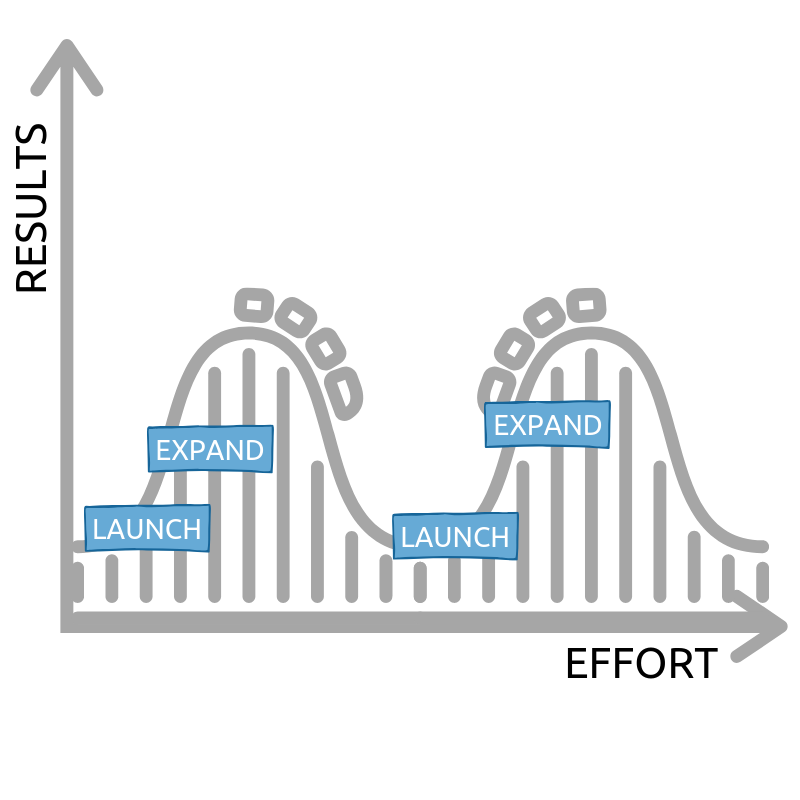
Whilst the natural instinct for many people – particularly those who have left a PAYE job and have got used to a steady paycheque – is to hope that their business will give them a constant and consistent income, for most small businesses this simply isn’t possible.
External influences in the economy, regulation changes and even fluctuations in the weather can mean you have little control over whether your business can give you this constant and consistent income. Add into the mix taking time out of your business for holidays or periods of illness, or nasty surprises such as your website getting hacked, a team member leaving you suddenly, or a higher than expected tax bill, and this can mean your cashflow has regular highs and lows.
But what if this feast and famine, that we are all programmed to believe is bad, was actually cycles of feast and fallow?
As working harder isn’t an option any more, as you are finding out, what if you could feel comfortable with the ups and downs in your business, the same way that we adapt to the change in our seasons?
Here in the UK, we plant our fields in spring, watch the crops grow in the summer and harvest in the autumn. Winter may be the dormant month but Mother Nature still works away, preparing the ground for the next cycle of feast for the following year. Crops need to be rotated and fields left fallow between the crops, to allow the soil to replenish itself.
The only way to plant in a different season and get a consistent and constant harvest is to control the growing environment with heated greenhouses, artificial sunlight and plenty of fertilisers and nutrients. So rather than forcing your growth with artificial sunlight and fertiliser, could you follow your natural business growth cycles?
What if we stopped trying to control the natural rhythms of business and work in tune with these feast and fallow cycles?
The True Profit Growth Flow
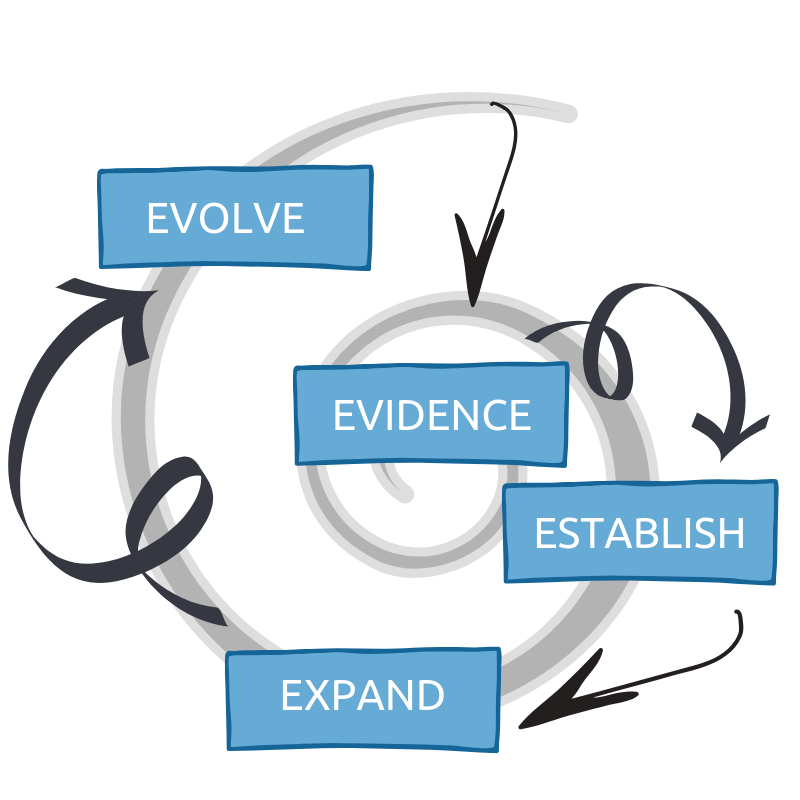
This is how I see growth working. There are four distinct phases of growth within a True Profit Business: evolve, evidence, establish and expand.
Evidence: getting proof that you have people who will buy what it is you offer by spending money with you.
Establish: getting feedback, building credibility and developing your business offer so you understand the results your clients get.
Expand: once you’ve proved that what you offer works, you can then start expanding your marketing systems, processes and team to build on your initial success.
Evolve: at some point, your systems and processes will stop working as well, as external factors change and your marketplace evolves. Which means that you have to evolve, too.
The new approach or idea you decide to take forward then drops back down into the Evidence phase again for you to find proof of concept. And so the Growth Flow continues back around.
You will notice there are no straight lines; the journey between each of these phases take you forwards, sideways and sometimes backwards before going forwards again. There’s no certainty of going from A to B to C to D. It’s more of a journey from A to B and then ‘Oh, shit, we need to go straight to G’ and then back to D before deciding to get C sorted before you go any further.
Through my research in writing my book, True Profit Business, and the work I’ve done with my clients over the past few years, I have seen this Growth Flow happen at all levels. It applies to your overall business journey across five to seven years, and it also applies to the specific lifecycle of your products and marketing campaigns. If you’ve been trying to take the approach of Launch and Expand, shown on the previous business growth chart in Figure 4, what you’ve essentially been doing is trying to go straight to phase three or four; Expand and Evolve.
If your own growth journey hasn’t been going as well as you have hoped, I hope that this gives you the reassurance that you haven’t failed. You are simply trying to navigate the ebbs and flows of the True Profit Growth Flow.
Over the coming weeks, I shall be sharing more about True Profit Business as my new book, True Profit Business, is published this September. In the meanwhile, I’d love to know what insights you have this article so do comment below and share your thoughts on what profit really means to you.
Thank you for reading. Until next time, do less, be more, play bigger.

















